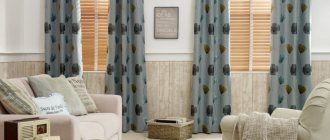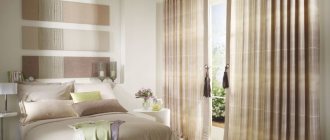When decorating the interior space of a private house, cottage or apartment, there are no trifles, because every detail and decorative item can affect the visual perception of a particular room. Curtains are also a decorative element that is of enormous importance for a window opening, which has a practical and aesthetic function at the same time. This textile is used to regulate the illumination of the room, as well as to hide household members from annoying neighbors.
However, recently, special attention has been paid to the aesthetic component, because curtains can become a decoration that emphasizes the window opening. The choice of curtains becomes more difficult if the room has a small window, which introduces a number of restrictions. How to choose the right curtains for rooms with small windows? Find out about it with us.
Which windows are considered small: norm and deviation
Standard window sizes are specified in GOST. They are calculated based on building codes and regulations for each residential premises separately, depending on the level of lighting, the total area of the rooms and the architectural ensemble as a whole.
According to GOST, the window width can be from 870 mm to 2670 mm, and the height - from 1160 mm to 2060 mm. The most common window size is height 1300 mm and width 1400 mm.
Windows having a height of less than 1300 mm and a width of less than 1400 mm are considered small, having specific features and a distinctive design. Window openings with a width of 600 mm or more are considered narrow, while window openings with a height of 560 mm are considered low.
General rules for choosing curtains for small windows
Curtains for a small window must be chosen based not only on the size of the window opening, but also on the general design style of the room.
You can visually enlarge a small window using a cornice that is 20 cm wider than the window opening on each side. But you don’t need to choose a cornice that is too wide - when you open the curtains, part of the wall will be visible, and this does not look aesthetically pleasing.
In rooms with a small area, there is no need to hang long curtains on the floor; it is better to opt for shortened models, with a slightly blurred vertical pattern - the room will be more spacious.
On small windows, window sill-length curtains made from plain light fabrics in pastel shades look beautiful.
When choosing curtains for a non-standard window, you need to avoid a large number of layers, draperies and ruffles, and if you want something original and elegant, you can opt for asymmetrical air curtains.
Low ceilings can be visually raised by using long curtains.
Country style
True rustic style involves using only natural colors and materials - in this case, curtains were no exception. Designers use three main fabrics - cotton, linen and chintz. Their simplicity and conciseness are ideal for this style.
Country is used in cases other than minimalism. They are hung on windows to complement the overall interior, filled with living vegetation, bright and rich flowers, and perfectly highlight furniture and accessories made of natural wood.
Drawings on a white background can be very diverse - berries, fruits and flowers. Despite the length of the curtains, the lightness of the fabric used allows them to be used even on the smallest windows.
Types of curtains for a small window
- Classic
Even a small window can be decorated with curtains in a classic style: short transparent or thick long ones, combined with airy tulle. Lambrequins will add especially chic, as they can also visually adjust the window opening, but excessive decoration and clutter, large ornaments and designs should be avoided.
- Curtains with hinges
Curtains with loops can be either long or short, and the loops for this type of curtain are made from the same material as the canvas itself. Most often, these curtains are used to decorate window openings in country style interiors, as well as modern neutral ones. They are especially convenient to use in a children's room or bedroom, as they move along the cornice completely silently, and also form beautiful, even folds.
You can use the loops to hang different types of curtains that are attached to the curtain rod: classic long or short, French or London, Italian or cafe curtains.
- French
French curtains are a real godsend for small windows. They are a canvas assembled into lush horizontal or vertical folds, which is attached using a lifting mechanism at the desired height.
It is better to combine French curtains with simple plain curtains, let’s say the ornament is simple and discreet. They are suitable for decorating a window opening in a spacious room, but it is better not to use them in a small room; they make the interior design heavier.
- Roman
Roman blinds are universal and suitable for both large and small windows. They are a canvas that, rising upward, forms beautiful folds.
Roman blinds can be combined with light tulle and classic curtains, because they are simple and laconic, stylish and elegant. For their manufacture, both light, airy and dense fabrics are used.
- Japanese
Japanese curtains can make a small window visually larger. They are fabric panels that slide smoothly along horizontal guides. They are adjusted by cords.
This type of curtain is simple and elegant at the same time; it can be combined with flowing curtains or transparent tulle.
- London
London curtains are a fabric fabric that is tightened on both sides with cords, forming a beautiful wave in the middle, and deep fan folds on the sides. When decorating small windows, they can be combined with Roman or roller curtains.
- Italian
Italian curtains are special curtains, which for the most part carry only a decorative load, because they do not cover the window from prying eyes from the street. They look luxurious and pompous, elegantly gathered into folds and flounces, which are secured with hooks. With their help, a small window can be made wider.
- Grandma's curtains
Granny curtains or cafe curtains look good on small window openings. By design, these are one or two curtains with small floral patterns, which are hung on a mini-cornice in the middle of the window. They will decorate the interior in Provence, country or modern rustic style.
- Hourglass
Hourglass is an ideal option for small windows, which makes them look sophisticated. They are a canvas tied in the middle with a cloth, ribbon or bow. This type of curtains makes the room design cozy.
- Rolled
Roller blinds are suitable for almost any window, they provide good protection from bright sunlight, and are very simple and practical to use. Roller blinds are a straight fabric that gathers into a roller, making it convenient to adjust their length. They are attached both to the window opening and to the cornice and can be combined with air curtains to decorate a tiny window.
- Without cornice
To make the interior lighter, many designers prefer not to use cornices for decorating small windows. Their function is performed by all kinds of hooks, decorative clothespins or metal holders, as well as fishing line or thin wire.
- Blinds
Blinds protect well from bright sunlight and prying eyes from the street; they are most often made of plastic plates, less often - of wood. This type of curtain is most often used in non-residential rooms, such as a bathroom, pantry or toilet, when the window needs to be closed especially tightly.
- Curtains for two windows
If there are two windows on one wall, then it is more expedient to decorate them together, combining them with a cornice or lambrequin into a single whole. This is especially beneficial when the window openings are small, because as a result the room will become visually more spacious.
Hourglass
Most often, this solution is used for narrow windows. For sewing, a single piece of light but durable fabric (organza or tulle) is used, which is attached to small cornices or strings at the top and bottom. The material, as a rule, is chosen in light colors - beige, white, the color of baked milk, light brown or gray. All kinds of bows, braid, and longitudinal lines look great.
In the middle, the canvas is intercepted with a ribbon, which can have the color that was used to sew the curtain itself, or another shade that can emphasize the overall interior of the room, the color of the window frame or furniture. Thanks to this element, this style resembles a huge hourglass, hence the name.
This is an ideal solution for small windows, since thanks to the interception of the canvas in the middle, space is created on the sides for the passage of daylight.
General features of choosing fabric and colors
The color of the curtains should be in harmony with the color scheme prevailing in the room.
Tulle, a lighter or darker tone of the curtains will visually increase the size of the window. It is better to avoid bright and catchy colors when decorating small window openings, with the exception of Japanese, roller or Roman blinds.
Your choice should be made on light fabrics - mixed or natural. The ideal option is white translucent textiles.
Classic curtains
Despite its centuries-old origins, the classic style of interior design remains relevant and in demand. With their charm they can transform any room beyond recognition, giving it rigor and elegance. A significant advantage in favor of choosing the classic style is the possibility of using it under almost any wallpaper and furniture, while maintaining clear and strict proportionality.
Read about: Greek curtains: harmony in simplicity and grandeur.
If you decide to turn to classic curtains, then you should pay attention to light, soft, discreet colors. These include beige, white, light yellow, soft brown and even honey. It is these colors that will allow your curtains not to stand out from the overall interior, but only to emphasize it, while letting a huge amount of daylight into the room.
You should not choose satin or silk fabric - they are quite difficult to process. The best solution for a classic style would be velvet, linen or cotton.
Rules for selecting curtains for small windows: adjusting the window proportions
- Wide low window
A wide, low window can be pulled up using a ceiling cornice, which should not protrude beyond the boundaries of the window opening. It is better to choose heavy, plain curtains on the floor or just below the window sill and hang them using eyelets or decorative rings. You cannot use large ornaments and vertical stripes; a light textured pattern looks good on such windows.
In the bathroom or toilet, you can use blinds or roller blinds.
Narrow long window
In order to correct a narrow window, you need to hang a cornice longer than the window opening by 25 cm on each side. Definitely with curtains, tulle must also be used, the length of the products should be up to the window sill or slightly lower. Straight, lightweight curtains made of one fabric - Japanese, Roman or roller - are suitable. You should not hang the curtain rod too high - this will lengthen the window even more. Also, a straight lambrequin with a horizontal pattern, or translucent tulle with thick straight curtains with tiebacks will help to slightly level the window opening.
Custom Beveled Windows
In order to make a sloping window beautiful, you should hang curtains on a special inclined cornice. You can visually enlarge a small window using long, light, plain curtains.
The shape of the beveled window opening itself is beautiful and original, therefore, you should not put too much emphasis on the curtains. Roman blinds work well, as do French or Austrian blinds.
Tulle with embroidery
To fit lace fabrics into the interior of a modern apartment requires special skill and style. What to do with old tulle curtains? Tulle looks most harmonious in settings with a Provence, country and shabby chic slant, and such curtains seem to be created for a country house.
Tulle fabric with embroidery adds romance to the room, looks slightly naive, but at the same time very elegant.
For the living room
When choosing curtains for small windows in the living room, it is better to avoid curtains of deep and saturated colors, and opt for cool, light shades that will visually enlarge the space. It is necessary to avoid sagging and multi-layering as much as possible; a good option is single-layer curtains with garters, in combination with translucent curtains and lambrequins.
Shuttlecocks
Another way to decorate a small window in a country house is to use flounces, which are frills made of fabric. They cover only the upper part of the window opening and serve as a decorative detail, since they provide neither privacy nor protection from the sun.
Thanks to the shuttlecock, you can admire the view from the window at any time. The solution will appeal to those who have abandoned traditional curtains, but do not want to leave the window opening undecorated.
To the kitchen
In the kitchen, curtains, first of all, should be practical, so you need to opt for short curtains in combination with shortened tulle or an airy lambrequin. You can also experiment with Austrian or English curtains in combination with roller or Roman curtains; cafe curtains would be very appropriate. It is very practical to use various grabs and clamps.
How to choose curtains, curtains and tulle in the same style for a private home
The combination of curtains and tulle is not an easy task. Even if a thick curtain and weightless tulle look stylish and impressive separately, in each other’s “society” they can either get lost or start “arguing” with each other. And if we are talking about non-standard design, then the situation is aggravated significantly.
Rustic curtains are predominantly made from linen, cotton or chintz.
The combination rules do not change.
- If you prefer voluminous curtain fabrics, then the tulle should be light and plain.
- If you prefer plain and smooth curtains, then tulle can be chosen with a voluminous printed pattern or even multi-colored.
Such curtains do not necessarily have to be long; on the contrary, shortened versions are often preferred.
By the way, modern design is very democratic. He takes some liberties. For example, in the photo the tulle is located in the second layer. And the glass itself is protected by roller blinds or blinds.
To ensure sufficient light enters the kitchen, a short curtain that lets in the sun's rays is a priority.
Even pompous classics look appropriate. Plain curtains and openwork tulle are a wonderful combination.
DIY curtain decor
You can decorate curtains with tiebacks and garters, which you can either buy ready-made or make yourself - this will add individuality and originality to the design of the room.
You can sew battens from scraps of curtains or tulle and decorate them with beads; tiebacks made from chains also look beautiful, especially if you string various decorative items on them.
Even simple hooks and clips can be turned into a work of art by gluing shells, pebbles, flowers or other little things on them that will highlight the overall interior. Even with ordinary buttons of different shapes, colors and sizes, you can create unique compositions.
In order not to clutter up a small window with unnecessary decor, you can trim the curtains themselves with openwork lace, fringe or tassels.
The photo gallery below shows examples of decorative elements that anyone can make.
Non-standard windows can be transformed with the help of the right textile design, masking imperfections and bringing its proportions closer to standard ones. Using curtains made from materials of different densities and colors, you can fill the room with additional light and also adjust the height of the ceilings. The design of a window opening can change the proportions of a room, emphasizing its advantages and hiding its shortcomings.
Light curtains
In a country house where there are rooms with large windows, you often want to maintain a feeling of air and spaciousness. At the same time, if the sun illuminates the room too brightly, fabric is needed to diffuse the rays. Refuse thick massive curtains in favor of light and light curtains: they will give the room lightness, but will not shade it too much.
At the dacha, textiles with ornaments are especially appropriate, adding coziness to the interior. Give preference to unobtrusive patterns without contrasting transitions from dark to light, so as not to visually overload the decor.











